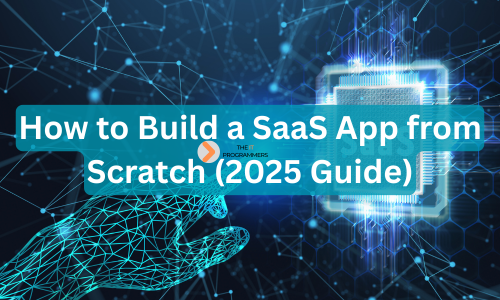Introduction: Why SaaS is Booming in 2025
Software as a Service (SaaS) continues to dominate the tech landscape in 2025. With low upfront costs, flexible pricing models, and scalability, more businesses and entrepreneurs are investing in SaaS products than ever before. If you’re looking to build a SaaS app from scratch, now is the perfect time. This comprehensive 2025 guide walks you through each phase of building a SaaS app from scratch from ideation to post-launch growth.
Whether you’re a solo developer or a startup founder, understanding how to build a SaaS app from scratch gives you a competitive edge. With a structured approach, clear roadmap, and the right tools, you’ll create a sustainable software product with long-term value.
Table of Contents
- Market Research and Idea Validation
- Planning Your SaaS Product
- Choosing the Right Tech Stack
- Designing the SaaS Application
- Developing the MVP (Minimum Viable Product)
- Setting Up Authentication and Payments
- Testing and Quality Assurance
- Deployment and Hosting
- Launch Strategies for SaaS Apps
- Post-Launch: Support and Customer Feedback
- Marketing and SEO for SaaS in 2025
- Scaling and Optimizing Your SaaS Business
- Security Best Practices in SaaS Development
- Final Thoughts
1. Market Research and Idea Validation
Before you dive into development, ensure there’s a real need for your product. Market validation is crucial when planning to build a SaaS app from scratch. Use surveys, competitor research, and one-on-one interviews with your target audience.
- Interview potential customers
- Join forums like IndieHackers, Reddit SaaS, and SaaS Communities on Slack
- Use tools like Google Trends and SEMrush to validate search interest
- Analyze competitors with SimilarWeb or Ahrefs
Tip: Avoid saturated markets unless you have a unique twist.
2. Planning Your SaaS Product
Once validated, outline your SaaS features using a Product Requirements Document (PRD):
- Core features (must-haves)
- Nice-to-have features (optional)
- User roles and permissions
- Billing model: subscription-based, freemium, usage-based
Tools: Notion, Trello, Miro
3. Choosing the Right Tech Stack
Tech stack decisions should prioritize speed, scalability, and security. For most SaaS startups in 2025, consider:
- Frontend: React.js, Vue.js, or Svelte
- Backend: Node.js, Laravel, Ruby on Rails
- Database: PostgreSQL, MongoDB
- Authentication: Auth0, Firebase Auth
- Payments: Stripe, Paddle
Cloud providers: Vercel, AWS, or DigitalOcean App Platform
4. Designing the SaaS Application
Great UX/UI can make or break your SaaS. Key elements to focus on:
- Mobile responsiveness
- Clean dashboard interface
- Dark mode toggle
- Accessibility (WCAG compliance)
Use tools like Figma or Adobe XD. Validate with user feedback before development.
5. Developing the MVP (Minimum Viable Product)
Your MVP should include only core features needed to solve the primary user problem. Avoid feature bloat.
MVP Checklist:
- Secure login
- Main functionality
- Admin panel
- Basic billing module
- Analytics dashboard
Version control with Git and deploy to staging environment early.
6. Setting Up Authentication and Payments
Security and monetization are essential.
- Authentication: Use OAuth, 2FA, and role-based access control (RBAC)
- Payments: Integrate Stripe or Paddle for subscription handling, tax compliance, and dunning management
Consider GDPR and PCI-DSS compliance from day one.
7. Testing and Quality Assurance
Never launch without extensive QA:
- Unit Testing: Jest, PHPUnit, Mocha
- Integration Testing: Cypress, Selenium
- Load Testing: Loader.io, JMeter
Use CI/CD pipelines (GitHub Actions, GitLab CI) for streamlined testing.
8. Deployment and Hosting
Choose serverless or containerized deployment:
- Serverless: AWS Lambda, Vercel
- Containers: Docker + Kubernetes on AWS or GCP
Use CDN for static assets and implement auto-scaling.
9. Launch Strategies for SaaS Apps
Timing your launch is crucial:
- Soft launch with beta testers
- Product Hunt and IndieHackers debut
- Use Launch Checklist (email sequences, press kit, feedback forms)
Start collecting testimonials and reviews immediately.
10. Post-Launch: Support and Customer Feedback
Support is vital to retention:
- Live chat: Intercom, Crisp, Tawk.to
- Ticketing: Zendesk, Freshdesk
- Feedback: Canny, Productboard
Create a public roadmap and changelog.
11. Marketing and SEO for SaaS in 2025
Without traffic, your app won’t grow. Focus on:
- Long-tail keywords with Rank Math SEO plugin (for WordPress landing pages)
- Blog posts, tutorials, case studies
- Social media: LinkedIn, Twitter/X
- YouTube explainer videos
- Influencer outreach (especially micro-influencers in tech)
Use tools like SEMrush, Ubersuggest, and Ahrefs for optimization.
12. Scaling and Optimizing Your SaaS Business
Once validated, scale wisely:
- Add team members: developers, customer success, marketing
- Introduce new features based on usage
- Track metrics: MRR, CAC, LTV, churn rate
- Implement AI/ML for automation and personalization
13. Security Best Practices in SaaS Development
Security is non-negotiable:
- End-to-end encryption
- Regular security audits
- Use HTTPS everywhere
- Database encryption
- Monitor with Sentry, Datadog
- Protect against XSS, CSRF, SQL Injection
Follow OWASP Top 10 as a baseline.
14. Final Thoughts
Building a SaaS app from scratch in 2025 requires planning, smart technology choices, and customer-centric thinking. With powerful tools, mature frameworks, and global market access, there’s never been a better time to launch your SaaS idea.
Take action today. Start with a validated idea, build your MVP, and iterate based on feedback. Whether you’re a solo developer or a team of entrepreneurs, the SaaS world is full of opportunity.
External Resources :
Related Post :


Responses